Laboratory Vessel “Energy Observer” in Namibia – The New Green Hydrogen Eldorado?
For its seventh and final stopover in Africa, Energy Observer dropped her anchor in Namibia, one of the world’s countries with the highest photovoltaic potential. The laboratory vessel stopped in a country that aims to become one of the world’s leading exporters of green hydrogen by 2030, even though it currently imports almost 60% of its electricity consumption and is utterly committed to the energy transition.
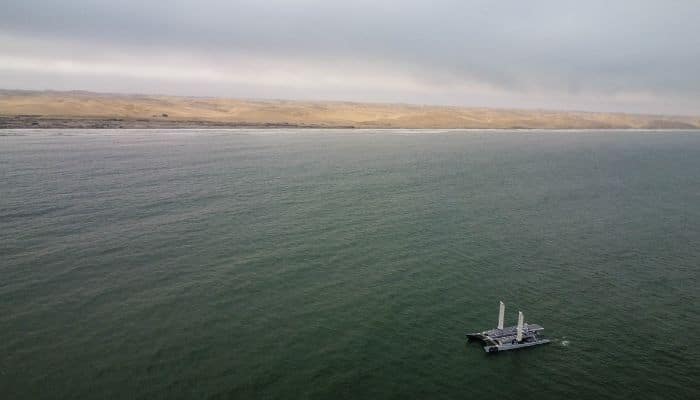
With an average of 300 days of sunshine a year and long days lasting between 11 and 14 hours, depending on the season, Namibia is just behind Chile, which holds the world record for sunshine. That’s over 3,000 hours of sunlight a year, in one of the continent’s most politically stable countries. Namibia’s cool temperatures are also a main factor in improving the efficiency of the photovoltaic panels, a phenomenon that the Energy Observer crew witnesses every day on the vessel’s deck. That is thanks to the cold Benguela marine current that runs along the west coast of southern Africa.
With its remarkable renewable energy and mining resources, massive investment in seawater desalination, and massive green hydrogen production projects, Energy Observer had to uncover and document the challenges facing this extraordinary country. For this 81st stopover, the laboratory vessel is docked at the Walvis Bay Yacht Club, the country’s only deep-water commercial port and future low-carbon fuel terminal, ideally located on the South Atlantic shipping routes.
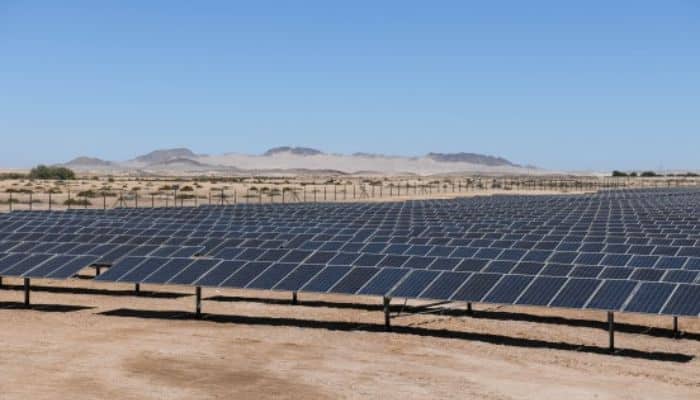
Namibia begins its energy transition
Agathe Roullin, onboard reporter, and Victorien Erussard visited and filmed an impressive seawater desalination plant installed by French company Orano.
One of Namibia’s main problems is the lack of water, with rainfall barely exceeding twenty millimeters a year in the west of the country (sixty times less than in Brest) and freshwater resources under enormous pressure from the mining industry.
As a reminder, Namibia’s subsoil is exceptionally rich, with uranium in particular (Namibia is the world’s 3rd largest producer) in the Erongo region (Walvis Bay). This mining resource accounts for around 10% of the country’s GDP and more than 60% of export earnings over the 2017-2019 period.
To remedy this shortage of fresh water and meet its needs, the French company Orano (formerly Areva) has installed the largest reverse osmosis seawater desalination complex in Southern Africa.
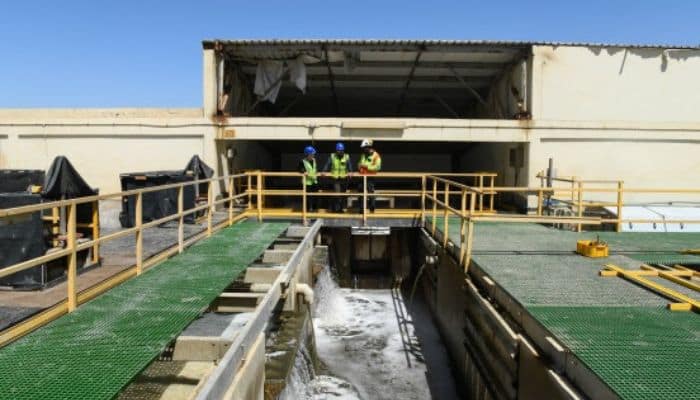

“The plant currently produces 12 to 13 million cubic meters of fresh water per year (1,800 m3 per hour), 90% for the mining industry and 10% for the local population,” explains Agathe Roullin, onboard reporter who visited the site with Victorien Erussard. “As the hydrogen economy matures, it’s clear that demand will continue to grow considerably, necessitating the creation of new plants like Erongo. The challenge will be to ensure that local populations benefit from it and that the impact on marine ecosystems is limited.”
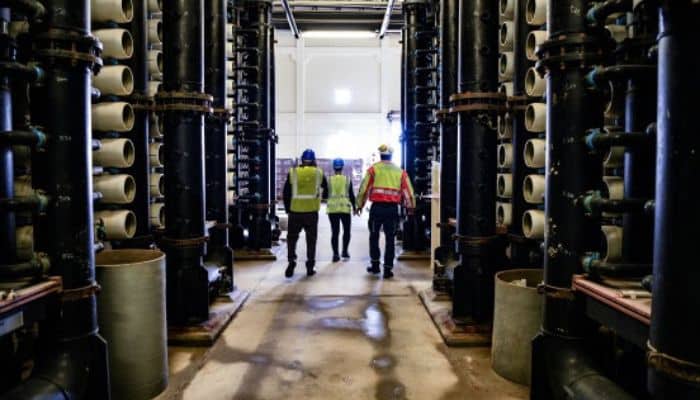
Orano reserves the right to almost double its annual production to 25 million cubic meters of fresh water, “the equivalent of 10,000 Olympic-sized swimming pools”, or even to invest further, increasing the site’s output to 45 million cubic meters.
That is also where the Namibian paradox comes to the fore. The seawater pumps that power the Erongo site are electrically driven and are themselves, powered by electricity purchased from neighboring South Africa.
“Namibia relies on imports for 60% of its electricity consumption, via contracts with South Africa among others, most of whose production is generated by coal-fired power plants…”.
In the short term, Orano wishes to decarbonize part of its business and has just embarked on the development of a solar power plant.
Projects and ambitions … for 2030
The energy transition is underway, even if it remains to be amplified. Several pioneers are already on the scene, including HDF Energy, which is planning a “Renewstable” solar power plant using green hydrogen to compensate for the intermittent nature of photovoltaics. The idea is to make “power to power”, by producing hydrogen as a means of storage (85 MW solar power plant) and using this electricity locally,” explains Tashiya Walenga, project manager. For the time being, we’ve set up a small station to monitor and measure the conditions and performance of the test solar panels, before starting construction in 2024.”

On a different scale, the Cleanergy Solutions Namibia joint venture (CMB TECH and O&L) has launched the construction of a demonstrator in the presence of Energy Observer, to be followed by a 10-hectare solar park, complete with a hydrogen production facility equipped with a 5 MW electrolyzer. The plant will be the first hydrogen production facility in southern Africa, directly harnessing the park’s solar energy to produce green hydrogen, which will then be distributed to a refueling station open to the public.
“Projects have been approved” continues Energy Observer’s team. Environmental studies have been carried out, and funding has been approved by the government. The country’s energy transition has begun, but it will still take a few years to materialize.”
Hyphen Energy, for example, plans to eventually produce 350,000 tonnes of green hydrogen every year, with 5 to 6 GW of renewable production capacity and around 3 GW of electrolysis capacity.
Or the Daures Green Hydrogen Village which aims to produce 31 tonnes of hydrogen and 109 tonnes of ammonia per year to start with. All the ingredients for producing green hydrogen are in place in a region with exceptional potential,” says Energy Observer’s team.
“Namibia’s political stability is exemplary on the continent,” adds Victorien Erussard. An asset for investors. The country is also clearly committed to its energy transition. With just 2.6 million inhabitants, it should soon be able to achieve energy autonomy. Namibia’s enormous potential undoubtedly opens up export prospects in the not-too-distant future, if its commitment is commensurate with its ambitions.”
Two main themes were filmed in Namibia, complementing the other subjects produced in Africa: for each country visited, an introduction to local energy balances called “How green is…” followed by a specific topic on decarbonized hydrogen production and its environmental and societal challenges.
The Odyssey continues, more great crossings
After the African continent, which enabled the crew to document and film numerous projects and issues specific to that continent, Energy Observer is heading west again for South America, another continent in transition.
The laboratory catamaran will set sail for Fortaleza (Brazil) this Tuesday, October 3, 2023, with a stopover on the island of St. Helena planned for this new Atlantic crossing. Fortaleza is at the heart of Brazil’s renewable energy ambitions, benefiting from a strong trade wind regime and therefore a stable and powerful source of wind.
Before departing for Brazil, the crew welcomed the ambassadors of Brazil and Spain, invited by Mr. Sébastien Minot, Ambassador of France. An operational showcase for the full range of technologies deployed in the country, the Energy Observer also invited a large number of Namibian officials, engineers, and managers on board, including the Ministers of Finance, the Environment, and Tourism.
Sun, wind, seawater, Energy Observer is in her elements to continue its world tour of the energy transition in the South Atlantic, meeting the most ambitious and innovative projects.
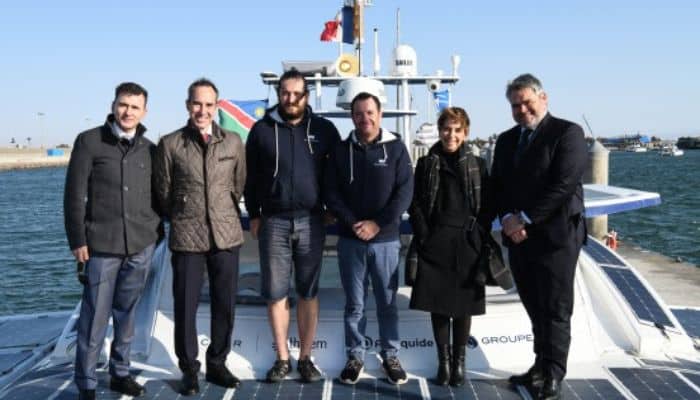
Press Release

Marine Insight Academy
Online courses for the Maritime industry!
Enroll For Maritime Courses
- 100 + Free & Premium Courses
- Learn at your own speed
- Earn certificates on completing Premium Courses
- Quizes to evaluate your knowledge
- Interactive videos

Marine Insight Academy
Enroll For Maritime Courses
- 100 + Free & Premium Courses
- Learn at your own speed
- Earn certificates on completing Premium Courses
- Quizes to evaluate your knowledge
- Interactive videos
Disclaimer :
The information contained in this website is for general information purposes only. While we endeavour to keep the information up to date and correct, we make no representations or warranties of any kind, express or implied, about the completeness, accuracy, reliability, suitability or availability with respect to the website or the information, products, services, or related graphics contained on the website for any purpose. Any reliance you place on such information is therefore strictly at your own risk.
In no event will we be liable for any loss or damage including without limitation, indirect or consequential loss or damage, or any loss or damage whatsoever arising from loss of data or profits arising out of, or in connection with, the use of this website.
Disclaimer :
The information contained in this website is for general information purposes only. While we endeavour to keep the information up to date and correct, we make no representations or warranties of any kind, express or implied, about the completeness, accuracy, reliability, suitability or availability with respect to the website or the information, products, services, or related graphics contained on the website for any purpose. Any reliance you place on such information is therefore strictly at your own risk.
Do you have info to share with us ? Suggest a correction
About Author
Marine Insight News Network is a premier source for up-to-date, comprehensive, and insightful coverage of the maritime industry. Dedicated to offering the latest news, trends, and analyses in shipping, marine technology, regulations, and global maritime affairs, Marine Insight News Network prides itself on delivering accurate, engaging, and relevant information.

About Author
Marine Insight News Network is a premier source for up-to-date, comprehensive, and insightful coverage of the maritime industry. Dedicated to offering the latest news, trends, and analyses in shipping, marine technology, regulations, and global maritime affairs, Marine Insight News Network prides itself on delivering accurate, engaging, and relevant information.
Related Articles
Daily Maritime News, Straight To Your Inbox
Sign Up To Get Daily Newsletters
Join over 60k+ people who read our daily newsletters
By subscribing, you agree to our Privacy Policy and may receive occasional deal communications; you can unsubscribe anytime.


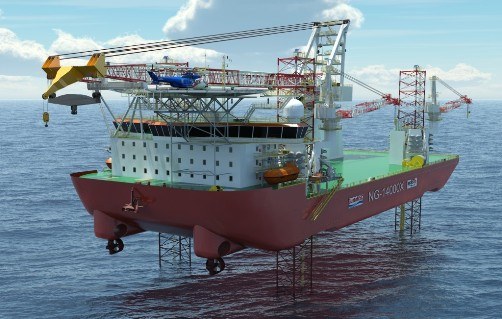
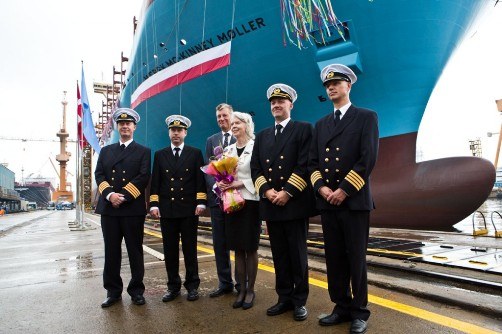
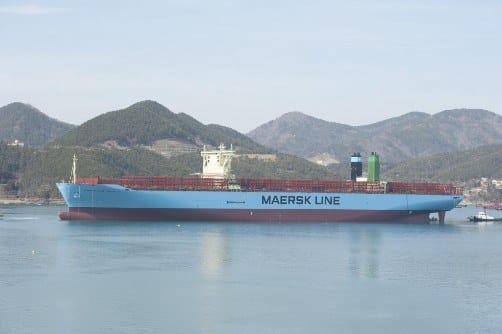

BE THE FIRST TO COMMENT